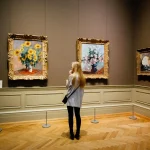As Sasa Paparella/Poslovni Dnevnik writes on the 1st of May, 2020, large European museums such as the Rijksmuseum, the Kunsthistorisches Museum in Vienna or the Stedelijk Museum in Amsterdam are losing between €100,000 and €600,000 a week because of the coronavirus pandemic. Croatia’s museums are reopening their doors, but the Zagreb earthquake has left traces on those here in the capital…
As museums reopen across Croatia, only three museums in Zagreb opened their doors this week: the Museum of Contemporary Art (MSU), the Klovićevi Dvori Gallery and the Typhlological Museum. According to the Ministry of Culture, three more museums are expected to open on Tuesday, May the 5th: the Ethnographic Museum, the Technical Museum and Atelier Meštrović.
The recent Zagreb earthquake: There was no evacuation plan in place for the collections
In the recent Zagreb earthquake, several museums in the capital were badly damaged, and now it appears that there was no plan to evacuate their collections in place at all.
”The museums arrange evacuation of the building with their founders. In this regard, the Ministry of Culture is currently finding a solution for two museums – the Croatian History Museum and the Croatian Sports Museum – whose buildings have been marked in red, meaning it isn’t possible for them to continue their operations without firstly thorough renovating the building. In addition to them, the Croatian School Museum also has a red mark on the building,” reads a statement from the competent ministry, whose jurisdiction includes other museums which suffered damage as a result of the Zagreb earthquake.
The Zagreb earthquake also severely damaged several museums under the jurisdiction of the City of Zagreb: The Archaeological Museum, MUO, and the Croatian Museum of Natural History. Poslovni Dnevnik sent an inquiry to the City of Zagreb, but they’re yet to receive an answer as to whether they had a plan in place for where the materials would be temporarily moved.
Most museums of national importance are located in Zagreb
Culture Minister Nina Obuljen Korzinek made a decision this week to implement a list of the damages caused by the Zagreb earthquake to museum materials. The damage list will be compiled by museum experts in coordination with the Museum Documentation Centre (MDC).
According to data from the MDC’s Register of Museums, Galleries and Collections in the Republic of Croatia, in the City of Zagreb alone, there are 41 museums (which include displaced collections too) containing 3.5 million or 57 percent of all museum objects in Croatia in 615 museum collections.
According to the Museums Act, the deadline for completing the inventory and the entry of museum material and documentation in the Register of Cultural Property of the Republic of Croatia is December the 31st, 2020.
Back in the middle of December 2019, a mere few months before the Zagreb earthquake struck, a conference on the Protection of the Cultural Heritage of the City of Zagreb in Crisis was organised by the Office for Emergency Management. The presentation then concluded that “the investment funds provided by the museum’s founders are insufficient for adequate preventive protection,” and that “reconstructions mainly regard cosmetic modifications but not structural reinforcements.”
According to data from the MDC website, as much as 40 percent of the museum and documentation materials of Zagreb’s museums are still not inventoried, and only nine percent of the total number of museum objects have been digitised. Most museum buildings are historic and not purpose built, and in the 21st century, only the Museum of Contemporary Art has been purpose-built, which already lacked storage space.
Safeguards containing the largest number of items are housed in the basements or attics of (old) buildings in adverse microclimatic conditions, at risk of flood and sewage damage, as well as fire and damage to installations.
Clearly, there will be no speedy return back to normal…
Concerning the other, global problem which is affecting the museum profession, the MDC has published the results of the Network of European Museum Organisations (NEMO) study entitled: The Impact of COVID-19 on Museums in Europe and the World.
“According to the first results of this survey, which was being conducted until April the 17th, 2020 at 650 museums in 41 countries, it’s clear that there will be no rapid return to normal,” concluded the study, which included museums from all 27 EU member states and nine Council of Europe member states. Various museums from the US, the Philippines, Malaysia, French Polynesia and Iran also responded.
Most museums (92 percent) in Europe and around the world are closed due to measures to prevent the spread of the coronavirus infection. By closing their doors to visitors, many museums have already experienced, or will feel, a drastic loss of revenue. This is especially true of larger museums, as well as those in tourist zones that have reported a financial loss in the range of up to 80 percent of their normal revenue, which is increasing every week due to the complete blockage of any tourist activities, but also because of the possibility of continued restrictions in the summer.
Some museums will unfortunately close their doors permanently.
This means that 30 percent of museums are losing up to €1,000 a week, 25 percent of museums are losing up to €5,000 a week, 13 percent are losing up to €30,000 a week, and five percent of museums are losing more than €50,000 a week. As touched on previously, large museums, such as the Rijksmuseum, the Kunsthistorisches Museum in Vienna or the Stedelijk Museum in Amsterdam, are losing between €100,000 and up to €600,000 a week.
Private museums haven’t provided any precise numerical data, but since most of their profits come directly from sales, some have already indicated that they lost their entire budget during their closure, and the fear is that the end result of the coronavirus crisis will be the permanent closure of their institutions.
For many of the closed museums, reopening dates haven’t yet been solidly determined. Museums who have responded to the survey predict that they may open their doors to visitors no later than September 2020.
When it comes to other sources of revenue, the survey says many museums report that they have already accessed or will be accessing national funding programmes for this crisis situation. These programmes mostly include coverage of wage expenditures and lost income.
Museums from 12 countries report that discussions on crisis funding programmes for culture are ongoing, in eight countries such funds already exist, and museums from 15 countries state that there is currently no crisis funding programme operating in their countries. Such programmes vary from country to country – some applied exclusively to publicly funded institutions and some exclusively to freelance professions. Most museums still haven’t needed to lay off staff. About 70 percent of museums report that they have modified their employees’ tasks to meet the current needs, and 50 percent of museums said more than 80 percent of their employees are currently working from their homes.
More than 60 percent of museums have increased their online presence.
However, the situation is not the same for staff on part-time contracts, nor is it the same for volunteer programmes that have been completely suspended in most museums, the survey said.
More than 60 percent of museums have increased their online presence since they’ve been closed, while 13.4 percent have increased their budget with online activities. Most museums use social networks more than they did before, making use of hashtags and presenting individual items to their audience.
Additionally, the number of virtual tours and online exhibitions has increased. Of the museums that responded to the survey, 40 percent have noticed an increased number of online visits since they’ve been closed to the public. Of that percentage, 41 percent are seeing a weekly increase in visits to their sites by up to 20 percent, and 13 percent of them are seeing an increase of as much as 500 percent a week.
The most popular tools and platforms for the internal communication of museum staff working from home turned out to be Zoom or Skype for conference video calls, and for chat – Microsoft Teams and Whatsapp.
Two-thirds of museums have increased their activities on social networks, almost 80 percent of them use mostly Facebook, and almost 20 percent use Instagram as a platform. A large number of museums are considering increasing their activities in podcasts, live streaming and game creation.
Make sure to follow our lifestyle page for more.









